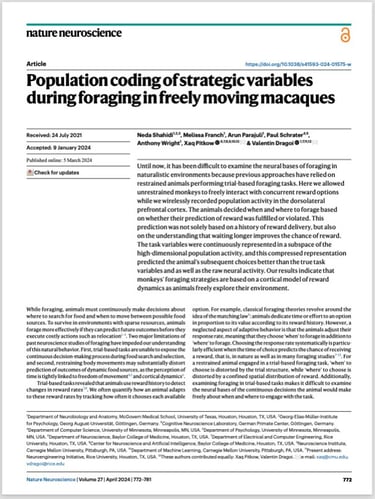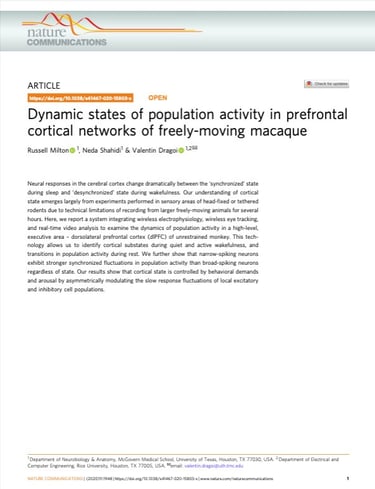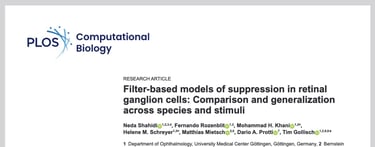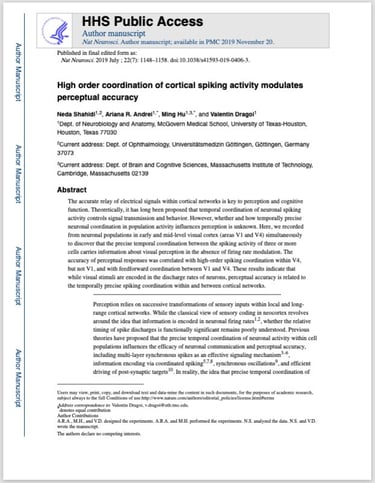Abstracts
Population coding of strategic variables during foraging in freely moving macaques
Until now, it has been difficult to examine the neural bases of foraging in naturalistic environments because previous approaches have relied on restrained animals performing trial-based foraging tasks. Here we allowed unrestrained monkeys to freely interact with concurrent reward options while we wirelessly recorded population activity in the dorsolateral prefrontal cortex. The animals decided when and where to forage based on whether their prediction of reward was fulfilled or violated. This prediction was not solely based on a history of reward delivery, but also
on the understanding that waiting longer improves the chance of reward. The task variables were continuously represented in a subspace of the high-dimensional population activity, and this compressed representation predicted the animal’s subsequent choices better than the true task variables and as well as the raw neural activity. Our results indicate that monkeys’ foraging strategies are based on a cortical model of reward dynamics as animals freely explore their environment.


Dynamic states of population activity in prefrontal cortical networks of freely-moving macaque
Neural responses in the cerebral cortex change dramatically between the ‘synchronized’ state during sleep and ‘desynchronized’ state during wakefulness. Our understanding of cortical state emerges largely from experiments performed in sensory areas of head-fixed or tethered rodents due to technical limitations of recording from larger freely-moving animals for several hours. Here, we report a system integrating wireless electrophysiology, wireless eye tracking, and real-time video analysis to examine the dynamics of population activity in a high-level, executive area – dorsolateral prefrontal cortex (dlPFC) of unrestrained monkey. This tech- nology allows us to identify cortical substates during quiet and active wakefulness, and transitions in population activity during rest. We further show that narrow-spiking neurons exhibit stronger synchronized fluctuations in population activity than broad-spiking neurons regardless of state. Our results show that cortical state is controlled by behavioral demands and arousal by asymmetrically modulating the slow response fluctuations of local excitatory and inhibitory cell populations.


Filter-based models of suppression in retinal ganglion cells: Comparison and generalization across species and stimuli
The dichotomy of excitation and suppression is one of the canonical mechanisms explaining the complexity of neural activity. Computational models of the interplay of excitation and suppression in single neurons aim at investigating how this interaction affects a neuron’s spiking responses and shapes the encoding of sensory stimuli.
Here, we compare the performance of three filter-based stimulus-encoding models for predicting retinal ganglion cell responses recorded from axolotl, mouse, and marmoset retina to different types of temporally varying visual stimuli. Suppression in these models is implemented via subtractive or divisive interactions of stimulus filters or by a response-driven feedback module. For the majority of ganglion cells, the subtractive and divisive models perform similarly and outperform the feedback model as well as a linear-nonlinear (LN) model with no suppression. Comparison between the subtractive and the divisive model depends on cell type, species, and stimulus components, with the divisive model generalizing best across temporal stimulus frequencies and visual contrast and the subtractive model capturing in particular responses for slow temporal stimulus dynamics and for slow axolotl cells. Overall, we conclude that the divisive and subtractive models are well suited for capturing interactions of excitation and suppression in ganglion cells and perform best for different tempora lregimes of these interactions.


High order coordination of cortical spiking activity modulates perceptual accuracy
The accurate relay of electrical signals within cortical networks is key to perception and cognitive function. Theoretically, it has long been proposed that temporal coordination of neuronal spiking activity controls signal transmission and behavior. However, whether and how temporally precise neuronal coordination in population activity influences perception is unknown. Here, we recorded from neuronal populations in early and mid-level visual cortex (areas V1 and V4) simultaneously to discover that the precise temporal coordination between the spiking activity of three or more cells carries information about visual perception in the absence of firing rate modulation. The accuracy of perceptual responses was correlated with high-order spiking coordination within V4, but not V1, and with feedforward coordination between V1 and V4. These results indicate that while visual stimuli are encoded in the discharge rates of neurons, perceptual accuracy is related to the temporally precise spiking coordination within and between cortical networks.


